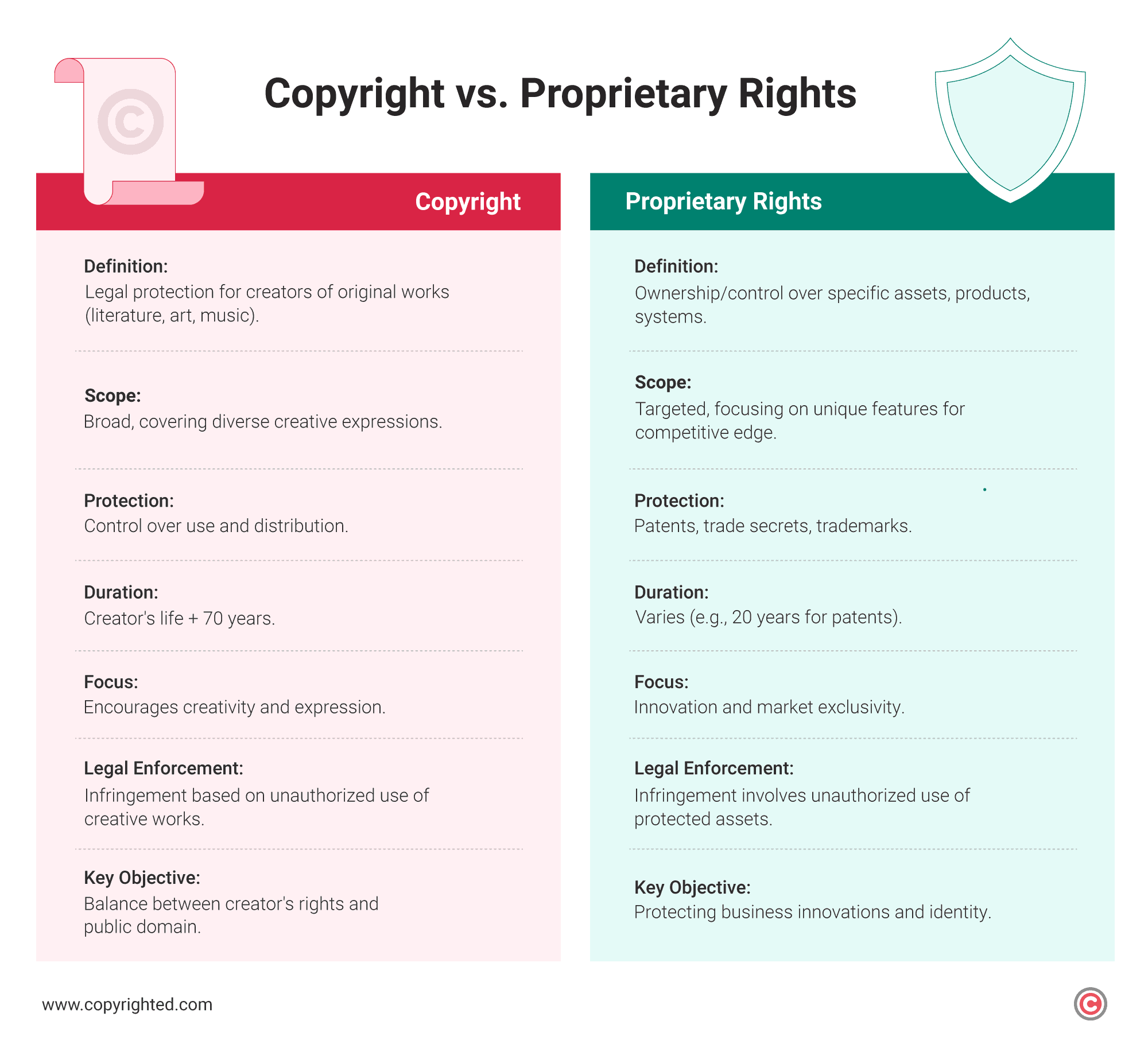You may be familiar with the concept of copyright protection for your creative endeavors, but is copyright really the ideal protection for your specific work?
The answer to this question actually depends on various factors, including the nature and scope of your work.
However, there’s another significant player in the domain of intellectual property, which is proprietary rights. Understanding how both copyright and proprietary rights operate is essential for individuals, businesses, and creators.
In this article, we’ll look at the concepts of copyright and proprietary, examining their unique features, differences, legal implications, and enforcement mechanisms.
- Copyright and proprietary rights are different concepts, each playing a unique role in the protection of intellectual property.
- Copyright has a broad scope, covering a wide range of creative expressions, while proprietary rights are more specific, targeting particular products or processes.
- In copyright, proving infringement may lead to cease and desist orders, while in proprietary cases, proving unauthorized use may result in injunctions or compensation claims.
Table of Contents
Is Copyright the Same as Proprietary?
No, copyright and proprietary are distinct concepts, although both center around protecting intellectual property.
Copyright serves as a legal concept designed to preserve the rights of creators, offering exclusive privileges to those who produce original works such as literature, art, and music. In contrast, Proprietary is centered around ownership or control over specific assets, products, systems, or designs, involving protection mechanisms like patents, trade secrets, and trademarks.
These protection mechanisms represent various types of intellectual property. Patents safeguard inventions, trade secrets protect confidential business information, and trademarks distinguish the source of goods or services.
The differences between copyright and proprietary rights extend across various aspects of intellectual property protection. While copyright has a broad scope, covering diverse creative expressions, proprietary rights have a more targeted focus.
Copyright shields the creators’ original works, providing control over their use and distribution, whereas proprietary rights concentrate on establishing ownership or control over particular elements to gain a competitive edge in the market.
Creators, businesses, and individuals must be aware of the specific characteristics, durations, and enforcement mechanisms associated with both copyright and proprietary rights. This knowledge is vital for effective protection of intellectual assets in today’s dynamic and competitive environment.
Understanding questions like, can you buy copyrighted work or license it legally is also part of navigating this landscape, as ownership and usage rights vary depending on the type of intellectual property involved.
What is Copyright?
Copyright is a legal concept that grants exclusive rights to the creators of original works of authorship, such as literary, artistic, and musical creations.
Copyright protection allows creators to control the use and distribution of their work for a specified period.
The fundamental purpose of copyright is to encourage creativity by providing creators with the incentive to produce original works without fear of unauthorized use. In essence, copyright empowers artists, writers, and musicians to express their creativity freely.
The time aspect of copyright protection is also important. Creators receive exclusive rights for a specific duration, typically starting when they create something and lasting throughout their life, plus an additional 70 years. This limited-time exclusivity aims to strike a balance, encouraging creative works to eventually become part of the public domain.
What is Proprietary?
In the world of intellectual property, “proprietary” means having ownership or control over something specific.
Unlike copyright, which mainly protects individual creative works, proprietary rights cover a wider range of intellectual assets, including products, systems, and designs. These rights are essential for protecting unique features that give a competitive edge in the marketplace.
Proprietary rights encourage innovation and investment in research and development by providing exclusive ownership or control. This support enables businesses and individuals to introduce new ideas, inventive processes, and distinctive brands without worrying about immediate copying or unauthorized use by competitors.
Embracing proprietary rights allows individuals and businesses to protect their unique innovations, processes, and brand identities
What is the Difference Between Copyright and Proprietary?
Understanding the difference between “copyright” and “proprietary” is essential to help you make well-informed decisions and protect your intellectual assets effectively.
Essentially, copyright protects original creative works like books and music, granting exclusive control for a set period. In contrast, proprietary rights focus on owning or controlling specific products, systems, or designs, providing a competitive edge.
To better comprehend the differences between copyright and proprietary, let’s break down their characteristics in a comparison table:

To illustrate, consider a scenario where a songwriter creates a melody and lyrics for a new song. If the songwriter registers their work under copyright, they gain exclusive rights to control how the song is used and distributed.
On the other hand, if a technology company develops a software application, securing proprietary rights becomes important to protect their ownership and control over their product.
In either case, it’s important to understand what does subject to copyright mean, as not all uses of a work require permission, especially when exceptions like fair use or public domain apply.
What are the Legal Implications and Enforcement Under Both Cases?
While copyright and proprietary protection share the goal of protecting intellectual property, they differ in scope, duration, and enforcement.
Copyright Cases
In copyright cases, proving infringement involves checking how much the allegedly copied work resembles the original.
This includes looking at the structure, expression, and overall feel of both works. It’s also important to consider whether the person accused of copyright infringement had seen the original material.
If it’s shown that they had access to the original work, it makes the infringement case stronger.
If infringement is proven, legal actions can be taken to protect the copyright holder’s rights. This may include issuing cease and desist orders, which demand an immediate stop to any infringing activities.
Seeking damages is also an option, allowing the copyright holder to claim financial compensation for losses due to the infringement.
In more severe cases, obtaining injunctions is a legal measure to stop further unauthorized use of the copyrighted material, forcing the infringing party to halt their activities.
The legal actions in copyright cases aim to protect creators by making sure their rights are respected and taking the necessary steps to address any infringement.
Proprietary Cases
In cases involving proprietary rights, proving infringement revolves around demonstrating instances of unauthorized use or replication of protected elements.
This often involves the improper use of confidential information, products, systems, or designs owned by someone else. If infringement is proven, legal actions can be taken.
One option is seeking injunctions, which are court orders that stop the infringing party from continuing their unauthorized activities, preventing further harm.
Compensation claims are another avenue available to the owner of proprietary rights. This compensation is meant to cover the financial harm the owner suffered due to the unauthorized use or replication, helping them recover their losses.
Additionally, legal action may mandate the infringing party to stop using the proprietary information entirely.
This could happen through court orders or legal agreements that force the wrongdoer to stop all activities involving the misuse of protected elements.
Frequently Asked Questions
Is copyright the same as proprietary?
No, they are distinct concepts. Copyright protects creative works, while proprietary rights involve ownership or control over specific assets.
What does copyright protect?
Copyright protects original works such as literature, art, and music, granting exclusive rights to the creators.
What falls under proprietary rights?
Proprietary rights involve ownership or control over specific assets, products, systems, or designs, including patents, trade secrets, and trademarks.
How is copyright infringement determined?
Copyright infringement involves assessing whether a work is substantially similar to the original and whether the alleged infringer had access to it.
How is proprietary infringement proven?
Proprietary infringement is proven by demonstrating unauthorized use or replication of protected elements.
Can proprietary rights be indefinite?
Yes, proprietary rights can potentially be indefinite if maintained by the owner.


